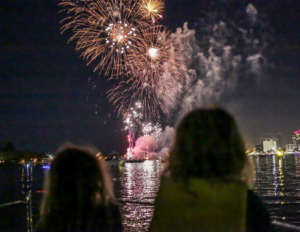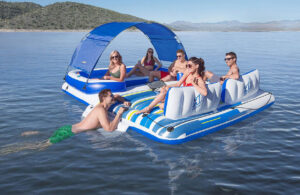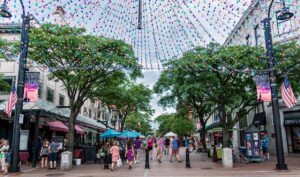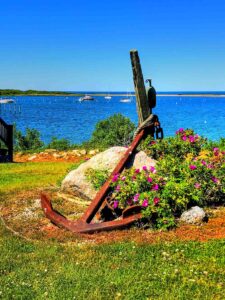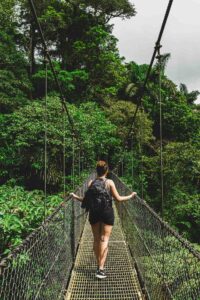
FLANKED BY THE PACIFIC OCEAN and Caribbean Sea, Costa Rica is a popular cruising destination for adventurous boaters. But digging into the country’s back story elevates it a step above most lush locations.
It’s got verdant vegetation, soft-sand beaches and ample amenities to keep a crew happy. But at this tropical isthmus, green means more than the color of its foliage. It’s a way of life and mark of pride in a country revered as a trailblazer in ecotourism and sustainable living.
In the 1960s when many Central American countries were engaged in mining, whacking down forests, and clearing land for cattle and agriculture, Costa Rica opted for a different path to conserve its natural resources. The shift started in 1963 when it established Cabo Blanco Absolute National Reserve and then in 1971 when the government began earmarking chunks of land as national parks. Embracing the idea that ecotourism is a viable industry, the country continued to protect its coastlines, interior habitats and rainforests, which today adds up to 26 national parks, 58 wildlife refuges, eight biological reserves — or nearly 30% of its national territory shielded from devastation.
The national mantra of “Pura Vida” (pure life) has garnered global recognition for Costa Rica’s commitment to respecting its piece of the planet, educating visitors about the value of conservation and entertaining guests with the awesome power of Mother Nature.
With ecotourism as a backdrop to this travel guide, we’d like to send you on a journey to Costa Rica, a land blessed with unparalleled beauty, unique creatures, exquisite habitats and pristine waters swelling with aquatic life. Moving from north to south on both coasts, you’ll discover a tropical boaters’ paradise.
Pacific Coast Destinations
PAPAGAYO GULF
Nestled into the northwest coastline, this gorgeous inlet benefited from a project by Costa Rica’s government to build a premier destination of all-inclusive resorts and hotels, while being mindful of protecting the waters and shoreline. Visitors can lounge on some of the country’s best beaches, play a variety of watersports and enjoy top-tier amenities such as an 18-hole golf course, marina, spas and shops. Tropical greenery frames white sand beaches, including popular sunbathing spots such as Playa Ocotal, Playas del Coco, Playa Hermosa and Playa Panama. Don’t be surprised if you see orcas, whales and other marvelous creatures swimming in the clear blue waves.
When you’re ready to explore the area, go to Santa Rosa National Park, where spider monkeys chatter in a tropical dry forest and sea turtles rest along the shore; Palo Verde National Park, where wetlands attract a menagerie of colorful migratory birds; or Rincón de la Vieja National Park to find hiking trails, Rincón de la Vieja Volcano, hot springs and waterfalls.
Where to Dock: Marina Papagayo
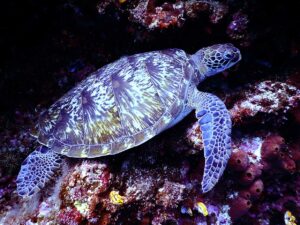
TAMARINDO
The Pacific Ocean is the main attraction in this charming beach town, renowned for turquoise waters, towering palm trees and scenic views at beaches such as Playa Tamarindo and Playa Langosta. Aquatic activities include snorkeling, diving, surfing, sailing, kayaking and sport fishing for marlin, sailfish and other saltwater catch. Favorites on land range from horseback riding and bicycling to hiking and golfing. When you work up an appetite after an active day at the beach, stroll along the timeless streets and sample the unique flavors of Costa Rican dishes. Shops and galleries are filled with treasures by local artisans.
For adventures just outside of town, head north to Playa Grande Beach to catch excellent waves or take surfing lessons. At nearby Las Baulas National Marine Park, you can carefully observe the nesting site for endangered leatherback turtles. And mangroves in the Tamarindo Wildlife Refuge create a haven for wildlife from howler monkeys to crocodiles.
Where to Dock: Marina Flamingo
NICOYA PENINSULA
On the Nicoya Peninsula, they don’t just care about the planet, but the people on it, too. It’s one of the world’s five “Blue Zones,” where residents live measurably longer and healthier lives, thanks in part to a laid-back vibe and nutritious local diet. The sunny climate and variety of ecosystems create a sanctuary for monkeys, sloths, sea turtles, parrots, dolphins, manta rays, and other creatures. The rugged terrain is famous for spectacular landscapes and seaside views. Best beaches include Montezuma, Malpaís, Carmen, Hermosa, Santa Teresa and Sámara, with a pink-sand bay that attracts tropical fish and waterfowl. The coral reef offshore is a diver’s heaven, and warm waters entice visitors to kayak, surf and go fishing.
Around full moons in the Ostional National Wildlife Refuge, olive ridley sea turtles come to shore by the thousands to nest. About 38 miles outside Sámara in Barra Honda National Park, Terciopelo Cave is open for public tours of its limestone stalactites and stalagmites.
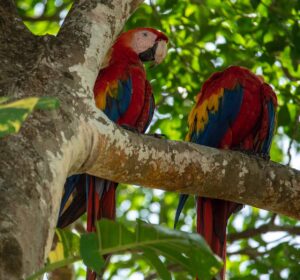
JACO BEACH
About two hours west of San José lies Jaco Beach, which is known for high-energy water sports and a vibrant nightlife. Surfing, snorkeling, kayaking and deep-sea fishing are popular activities, along with catamaran tours of the gorgeous coastline. Fans of pumped-up adrenaline pastimes take part in waterfall rappelling, ATV tours, rafting and zip lining above the jungle canopy.
It’s a springboard for day trips to Carara National Park, known for diverse habitats that shelter creatures from scarlet macaws and crocodiles to poison-arrow frogs and two-toed sloths. Bijagual Waterfall, a 600-foot cascade plunges over the stony side of a mountain, and Mount Miros, is at the end of a 1.7-mile hiking trail that unveils spectacular views of Jaco.
Where to Dock: Los Sueños Resort & Marina
QUEPOS & MANUEL ANTONIO NATIONAL PARK
As a beautiful port with a rainforest backdrop, Quepos is a harbor village famous for big-game sport fishing and as the gateway to Manuel Antonio Park. Restaurants, bars, hotels, galleries and gift shops surround the waterfront where the main beach and charter fishing fleet await and the offshore waters are teeming with aquatic life. Its Marina Pez Vela opened in 2014, has about 200 wet slips that accommodate boats up to 200 feet and hosts fishing tournaments every year. Nearby beaches include Playa Espadilla and Playa Biesanz. Northwest of town, Damas Island mangrove estuary is home to wildlife, reptiles and iguanas.
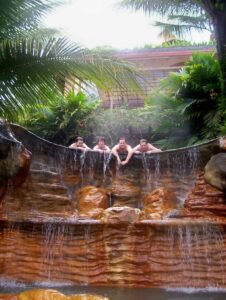
Manuel Antonio Park is an ecotourist’s playground. Its protected rainforest, mangroves, lagoons and beaches offer shelter to 350 species of birds, 110 species of mammals and a variety of monkeys. Hiking trails lead to striking views of the coastline, stellar vistas and offshore islands. Scientists and naturalists come here to study the diverse flora and fauna.
Where to Dock: Marina Pez Vela
OSA PENINSULA & GOLFO DULCE
With Drake Bay to the north, the Pacific Ocean to the west and Golfo Dulce on the east side, Osa Peninsula is a premier rainforest destination. The peninsula, regarded as one of the most biologically intense spots in the world, is home to breathtaking scenery, pristine beaches, exceptional scuba diving and plentiful wildlife. With a population of about 3,000, Puerto Jiménez is the main town that was once fueled by gold mining and logging, but now revolves around the ecotourism industry.
Nature explorers flock to Corcovado National Park, which covers about half of the peninsula and is populated with tropical birds, monkeys, sloths, and endangered jaguar and puma; and Caño Island Biological Reserve, which lies 12 miles offshore in Drake Bay, was once a pre-Columbian cemetery but is now a sanctuary for snorkelers and divers chasing colorful fish.
Where to Dock: Marina Bahia Golfito
Caribbean Coast Destinations
TORTUGUERO NATIONAL PARK
In the northeast part of Costa Rica next to Barra del Colorado Wildlife Refuge, this park is best visited by boat from April to mid-October if you’re here for turtle nesting season. Four species of sea turtles — green, leatherback, hawksbill and loggerhead — arrive each year to lay eggs. The Sea Turtle Conservancy runs a research center and visitor station. Other attractions that showcase the region’s biodiversity in this maze of wetlands, canals, rivers, lagoons, beaches and thick rain forest include hiking trails, zip lines, hanging bridges, sport fishing, bird watching (300 species) and spotting endangered species such as macaws, manatees and jaguars.
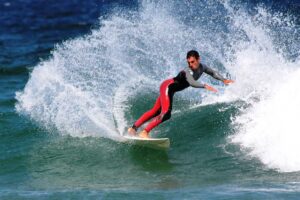
VERAGUA RAINFOREST
Located about 30 minutes east of Puerto Limón, Veragua presents fabulous views of the Talamanca mountains’ flora and fauna. This 3,000-acre rainforest reserve and scientific research center encourages visitors to watch the antics of its protected inhabitants – monkeys, sloths, tree frogs, reptiles, birds, butterflies and more. To find them, you can choose among hiking trails, aerial gondolas or zip lines that glide above the treetops.
Must-see attractions include the nearly 100-foot-tall Puma Waterfall that tumbles water down a rocky mountainside, reptile terrarium, butterfly garden, museum that highlights insects’ role in ecosystems, and an exhibit on nocturnal frogs.
CAHUITA NATIONAL PARK
Established in 1970 to protect the offshore coral reef, this park aims to entertain ecotourists by land and sea. Hiking trails wind through forests filled with birds, monkeys, racoons and other indigenous creatures. With at least three shark species, 35 coral species and 125 types of fish swimming around the reef, snorkeling with a certified guide is a colorful aquatic adventure, especially if you find the two sunken ships with cannons pointing toward the sea’s depths.
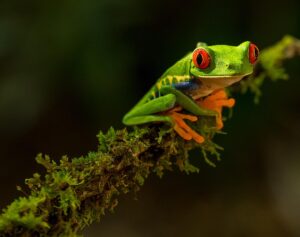
The nearby coastal town of Puerto Viejo de Talamanca is a mecca for the international surfing crowd, sun worshipers and scuba divers. Its kick-back vibe reflects an eclectic fusion of Afro-Caribbean, Latino and local indigenous cultures. Take time to check out the array of beachfront bars, boutiques, gift shops and restaurants.
GANDOCA-MANZANILLO WILDLIFE REFUGE
Situated a few miles north of the Panama border, this reserve is comprised of a lowland rainforest, wetland and mangrove swamp, and protects several of the region’s endangered habitats, oyster beds and coral reefs. It’s known for exceptionally beautiful beaches and tropical foliage along the shore, and is a nesting area for sea turtles, manatees, dolphins, crocodiles and other creatures. Parakeets, toucans, parrots and other feathered friends are often spotted in the trees.
The quiet fishing village of Manzanillo is located inside the reserve. Relax in warm Caribbean waters of its white sand beach, then savor a meal of the local cuisine at a seaside restaurant.


